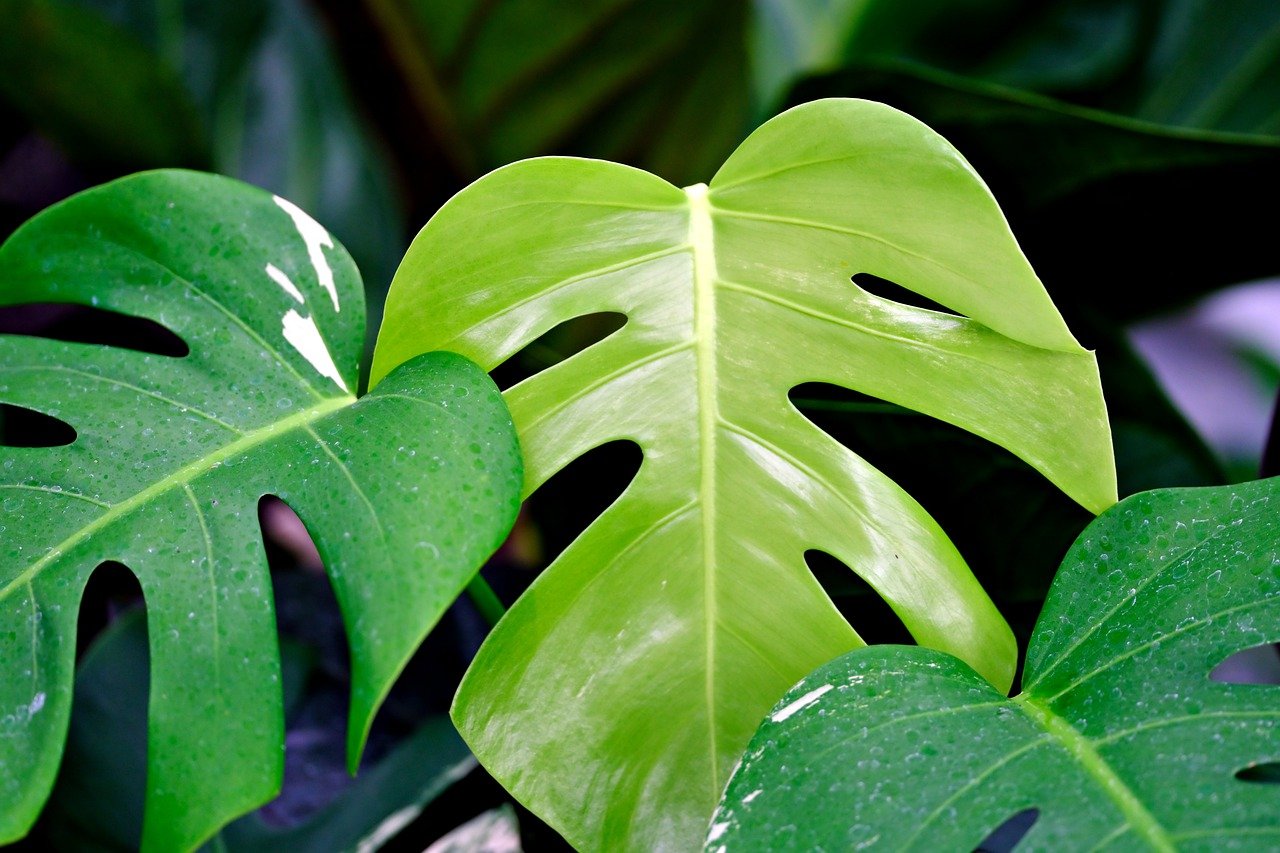1. Botanical Details and Varieties:
- Botanical Information:
- Genus: Monstera (Family: Araceae)
- Native to tropical rainforests in Central and South America
- Unique characteristics: large, perforated leaves (fenestrations) that develop as the plant matures
- Popular Varieties and Hybrids
Here’s a list of the most popular Monstera varieties and hybrids kept as houseplants, known for their stunning foliage and unique growth patterns:
Monstera deliciosa (Swiss Cheese Plant)
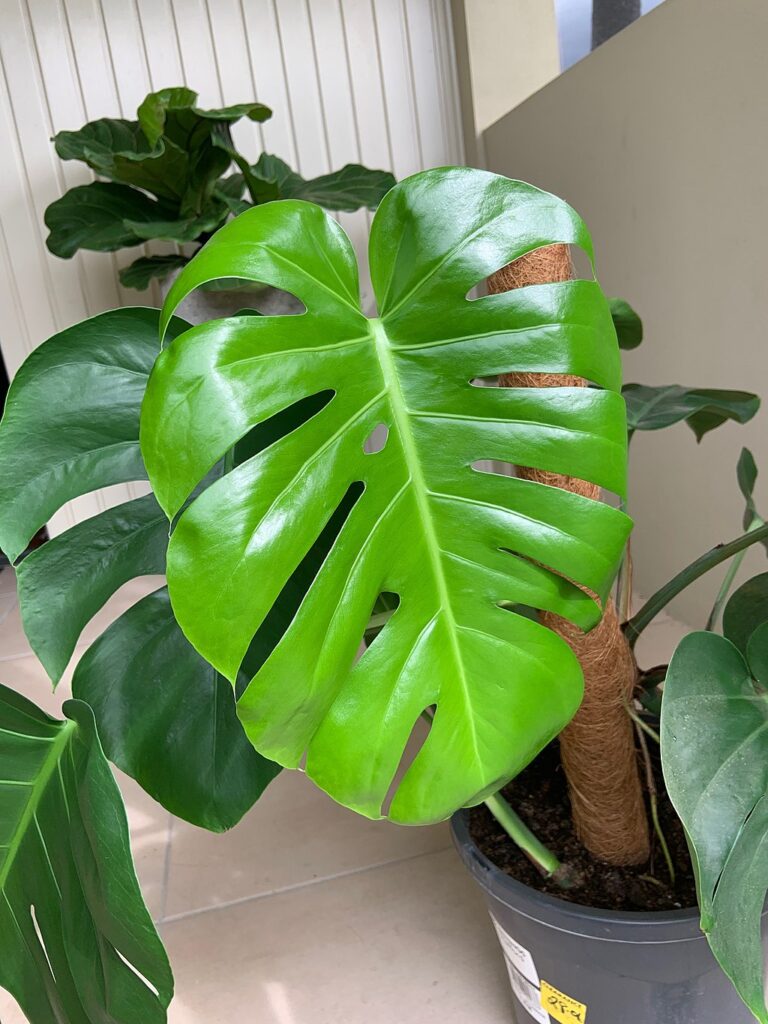
- Description: The classic Monstera with large, split, heart-shaped leaves. Known for its iconic perforated foliage that develops as the plant matures.
- Common Feature: Easily recognizable due to its large, dramatic leaves with holes and slits.
Monstera adansonii (Swiss Cheese Vine)
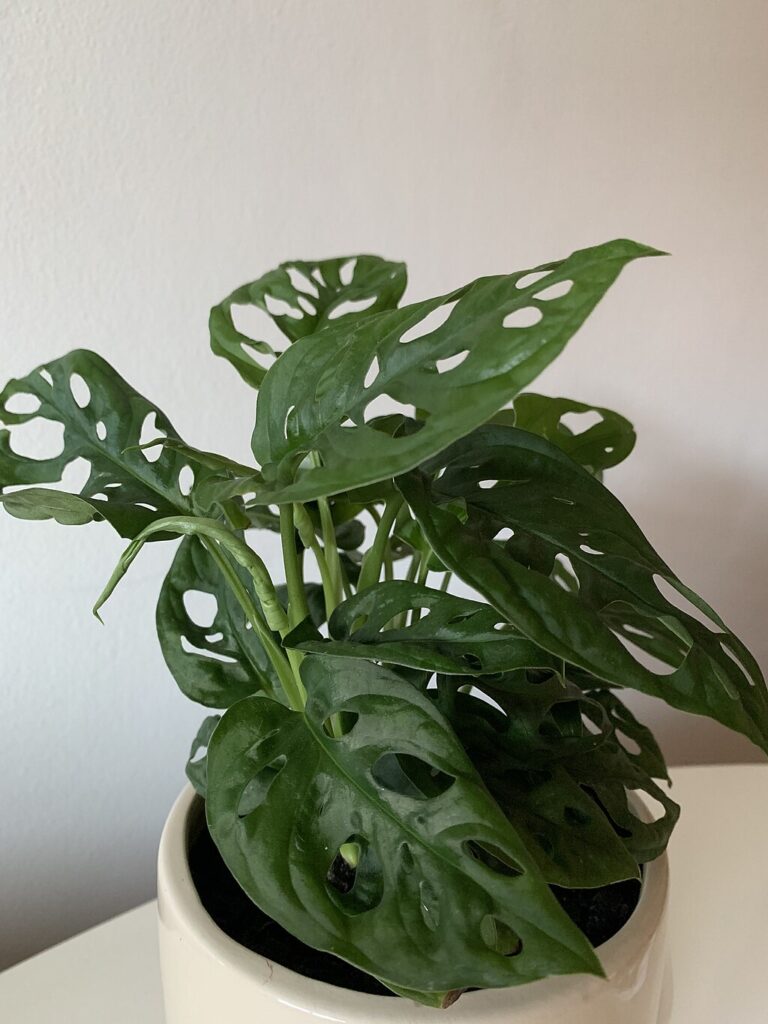
- Description: A smaller version of Monstera deliciosa, with elongated leaves that have distinctive holes.
- Common Feature: Its “Swiss cheese” holes are smaller and more frequent than those of Monstera deliciosa, and it has a vine-like growth habit.
Monstera borsigiana
- Description: A more compact variety of Monstera deliciosa, with slightly smaller leaves and more delicate growth.
- Common Feature: Often confused with Monstera deliciosa, but typically more bushy and shorter in stature.
Monstera siltepecana
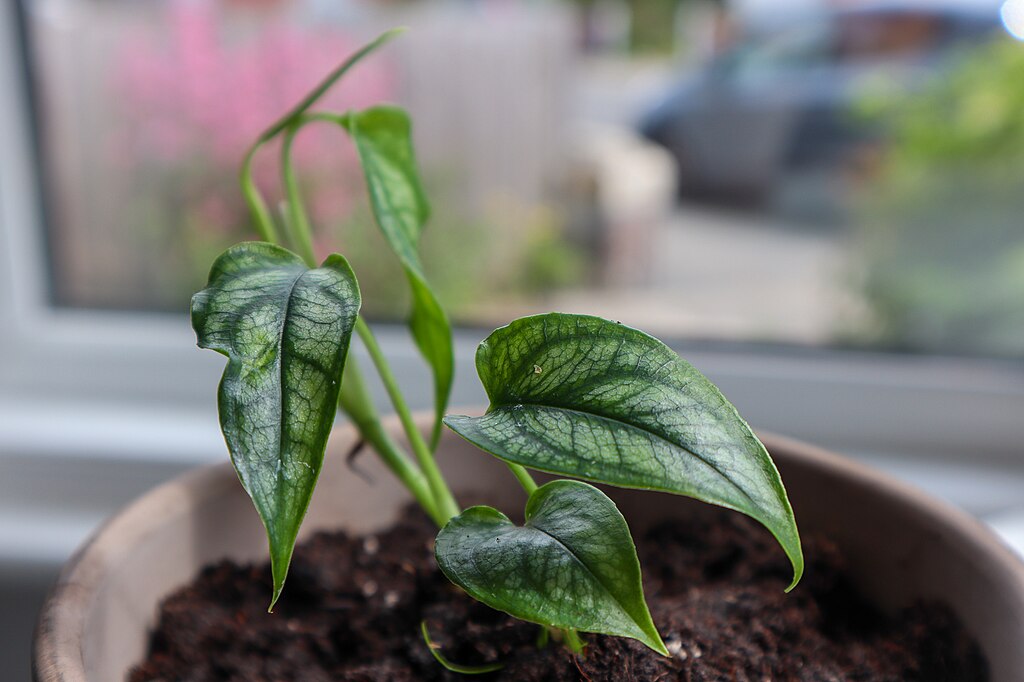
- Description: Known for its striking silver-gray or blue-green leaves with variegated patterns.
- Common Feature: It has a climbing vine habit and is prized for its unique and attractive foliage, especially as the plant matures.
Monstera obliqua
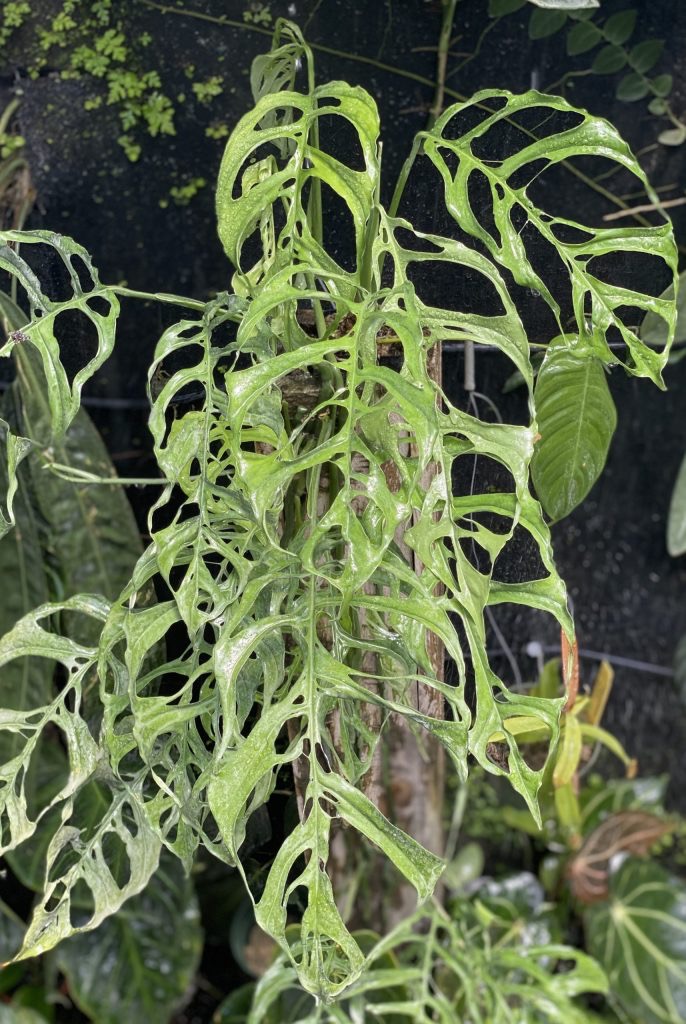
- Description: Known for its incredibly thin, delicate leaves with large holes. It is one of the rarest and most sought-after Monstera varieties.
- Common Feature: Extremely holey leaves, with minimal green tissue, making it look almost transparent.
Monstera standleyana
- Description: A climbing plant with long, narrow leaves that feature creamy white or yellowish variegation.
- Common Feature: The variegated form is less common but highly prized for its beautiful leaf patterns.
Monstera variegata (Variegated Monstera deliciosa)
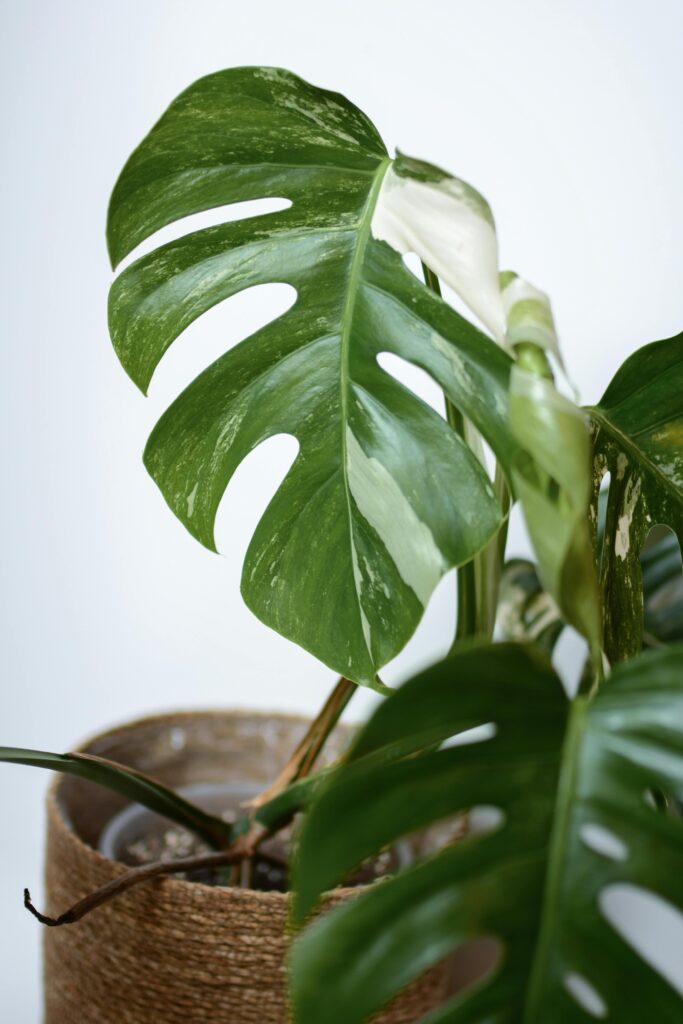
- Description: A highly sought-after variety with white or cream-colored patches on its leaves, in addition to the typical splits and holes.
- Common Feature: The variegation can vary from leaf to leaf, giving each plant a unique look.
Monstera pinnatipartita
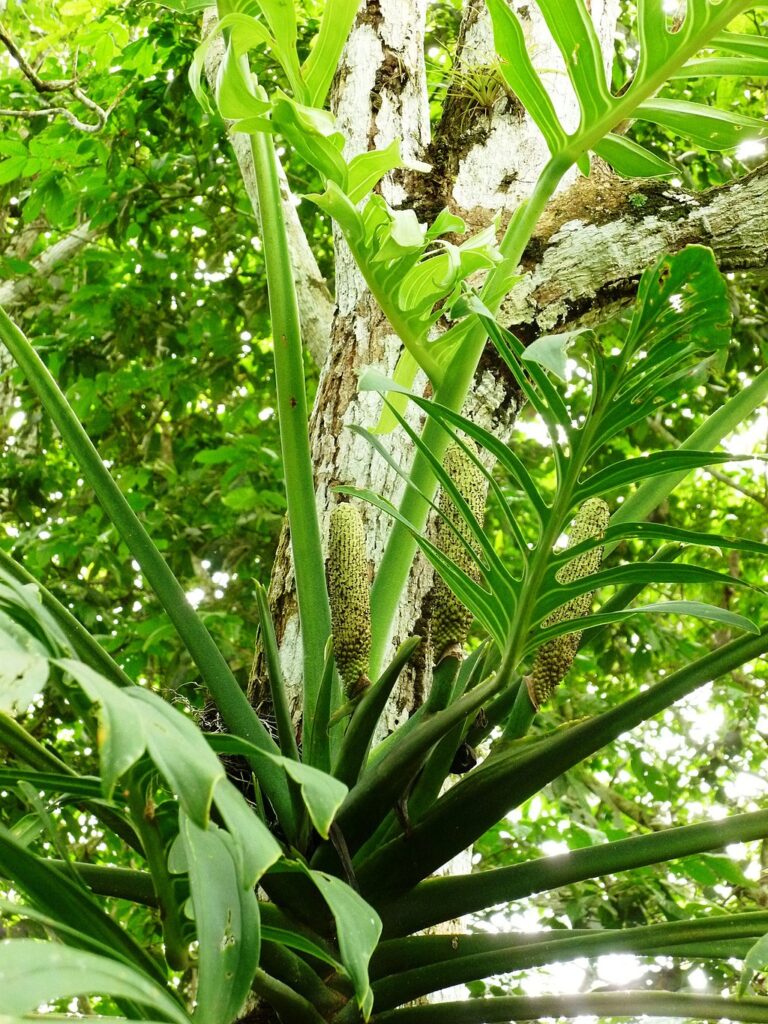
- Description: Known for its long, narrow leaves that begin to split and form deep lobes as they mature.
- Common Feature: Unlike the broad leaves of Monstera deliciosa, this variety features thinner, deeply divided leaves.
Monstera dubia

- Description: A more compact Monstera variety with smaller, heart-shaped leaves that have a silvery or light green appearance.
- Common Feature: It’s known for its beautiful foliage, which changes as it matures, starting out small and rounded before becoming more dissected and deeply lobed.
Monstera epipremnoides
- Description: A climbing variety with long, narrow leaves that develop dramatic slits and holes as the plant ages.
- Common Feature: Similar in appearance to other Monsteras, but with a unique, longer leaf shape and a more climbing habit.
Monstera ‘Thai Constellation’
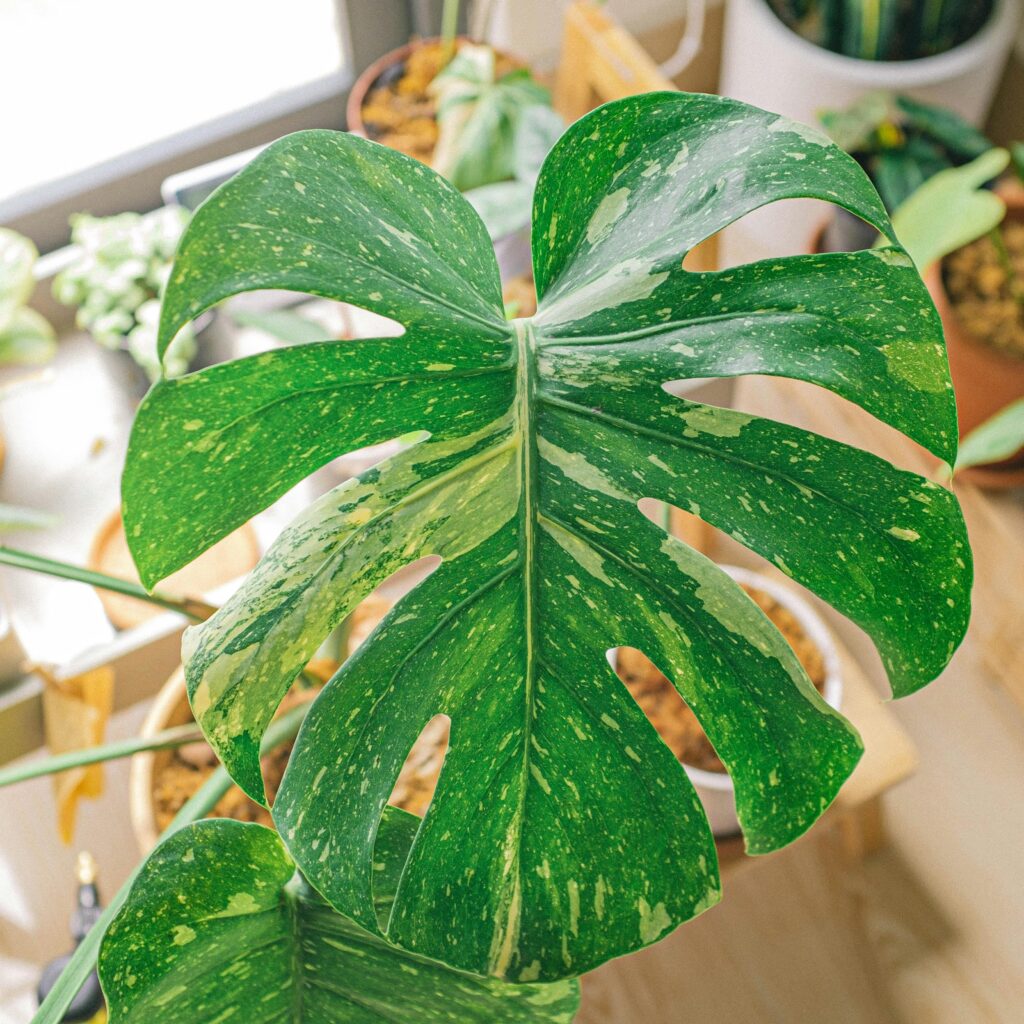
- Description: A variegated cultivar of Monstera deliciosa with distinctive white marbling or speckling.
- Common Feature: Known for its bold, irregular variegation, which can include large patches of white or cream.
Monstera ‘Albo-Variegata’
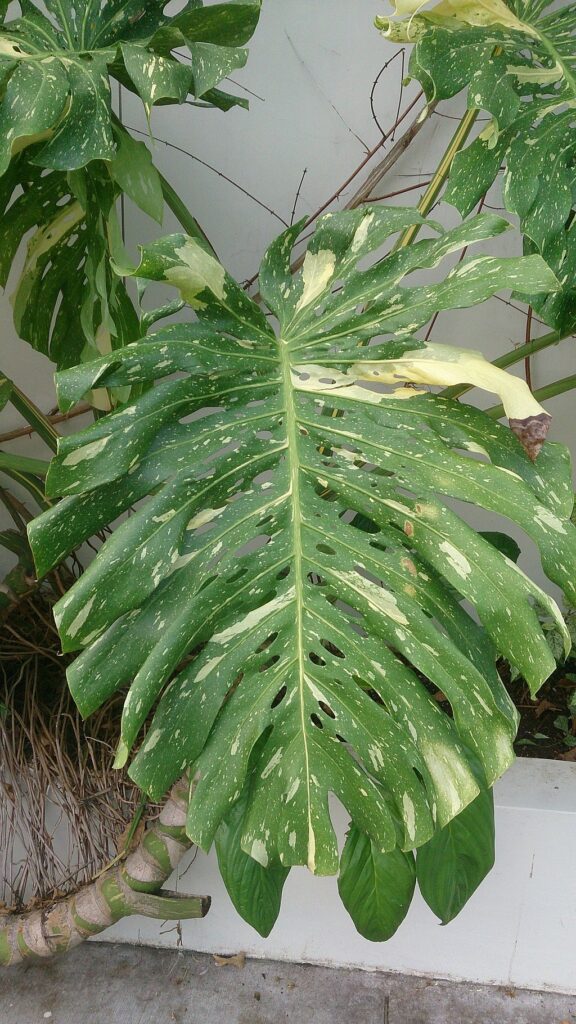
- Description: Another variegated form of Monstera deliciosa, this one is highly prized for its striking white and cream variegation.
- Common Feature: Often considered a must-have for collectors, with beautiful contrast between the dark green and cream-colored areas on the leaves.
Monstera ‘Marble Queen’
- Description: A variety of Monstera deliciosa with marble-like variegation.
- Common Feature: The leaves feature a beautiful, irregular mix of dark green and white.
Monstera ‘Marmorata’
- Description: A variegated hybrid of Monstera with highly marbled leaves.
- Common Feature: Highly decorative, with bold white streaks contrasting with dark green.
Monstera ‘Fastigiata’
- Description: Known for its upright, columnar growth and smaller leaves with a more orderly arrangement.
- Common Feature: Unlike other Monstera species, this variety has a more vertical, less sprawling growth habit.
Bonus Hybrids & Crosses:
- Monstera x adansonii ‘Friedrichsthalii’ (Friedrichsthalii Hybrid): A hybrid between Monstera adansonii and Monstera obliqua, prized for its narrow leaves with larger holes.
- Monstera ‘Esqueleto’: A rare hybrid, often grown for its beautiful, web-like foliage with deep cuts and holes.
The Monstera family includes both well-known varieties like Monstera deliciosa and rarer hybrids with unique patterns and growth habits. Whether you’re drawn to dramatic variegation or unique leaf shapes, there’s a Monstera for every type of plant enthusiast!
2. Ideal Growing Conditions:
General Care Tips for All Monstera Varieties:
- Soil: Well-draining, all-purpose potting mix with added perlite or sand for drainage.
- Fertilization: Fertilize monthly during the growing season (spring to summer) with a balanced, liquid fertilizer.
- Repotting: Repot every 1-2 years or when the plant outgrows its pot.
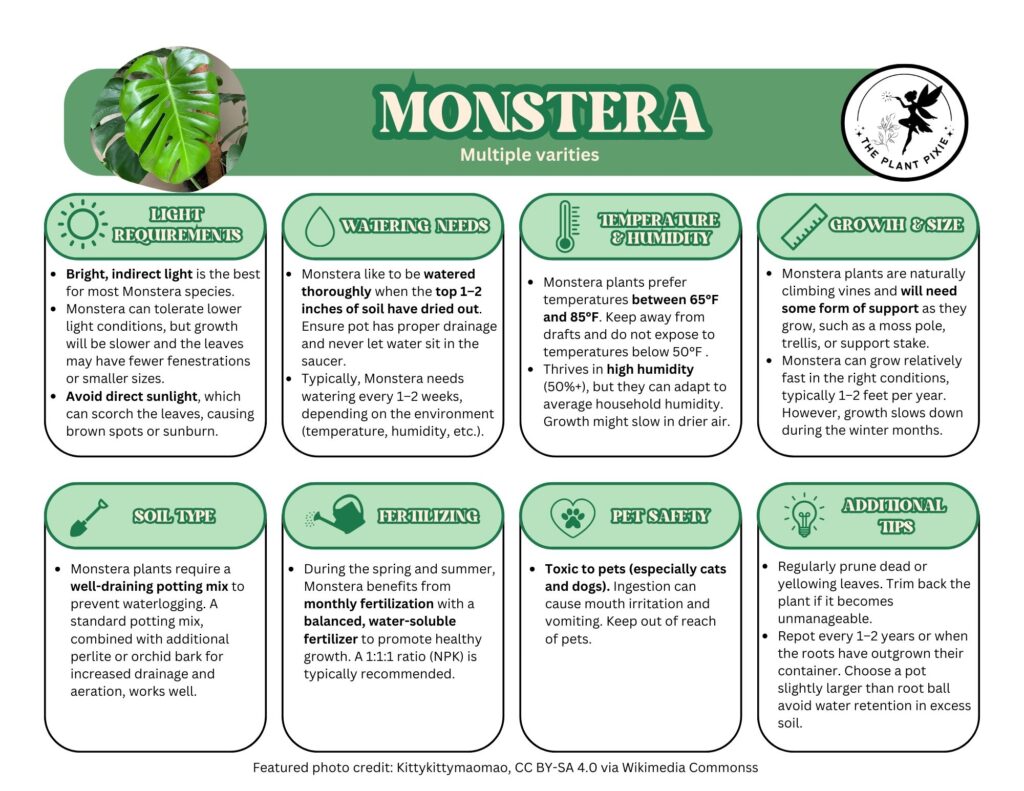
While most Monstera varieties share similar general care requirements, there are some differences based on their growth habits, size, and the unique needs of specific varieties. Here’s a breakdown of the care considerations for the popular Monstera varieties mentioned above:
Monstera deliciosa (Swiss Cheese Plant)
- Light: Prefers bright, indirect light. Can tolerate some direct sunlight but may scorch the leaves.
- Watering: Water when the top 1-2 inches of soil are dry. It’s more tolerant of drought than some other Monsteras.
- Humidity: Moderate to high humidity, but it can adapt to average indoor humidity levels.
- Growth: Large leaves with holes as the plant matures. Prune regularly to control size.
- Additional Care: Can tolerate lower light conditions, but growth will slow.
Monstera adansonii (Swiss Cheese Vine)
- Light: Bright, indirect light, similar to M. deliciosa. It may tolerate some lower light, but the plant will stretch out and become leggy.
- Watering: Prefers slightly moist soil. Water when the top 1 inch of soil feels dry.
- Humidity: High humidity is ideal, but it can adapt to average humidity.
- Growth: A vining species that grows long tendrils. It may need a support structure to climb.
- Additional Care: Regular pruning to keep the plant bushy and prevent leggy growth.
Monstera borsigiana
- Light: Bright, indirect light. Can tolerate low light but may grow slower.
- Watering: Water when the top 1-2 inches of soil dry out.
- Humidity: Moderate to high humidity.
- Growth: More compact and bushy than M. deliciosa, making it ideal for smaller spaces.
- Additional Care: Prefers to be a bit root-bound, so repotting can be done less frequently.
Monstera siltepecana
- Light: Bright, indirect light.
- Watering: Keep the soil slightly moist but not soggy. Water when the top 1 inch of soil is dry.
- Humidity: High humidity is ideal for this variety.
- Growth: A smaller plant compared to M. deliciosa, with silver or blue-green leaves.
- Additional Care: Provide a moss pole or trellis for support, as it tends to climb.
Monstera obliqua
- Light: Bright, indirect light is essential. Avoid direct sunlight, which can scorch its delicate leaves.
- Watering: Water when the top inch of soil is dry. Overwatering or underwatering can damage the plant quickly.
- Humidity: Very high humidity is needed for this rare, finicky plant.
- Growth: Slow-growing with delicate, thin leaves and large holes. Often more difficult to grow than other Monsteras.
- Additional Care: Needs a lot of care in terms of temperature and humidity. Ideal for advanced plant owners.
Monstera standleyana
- Light: Prefers bright, indirect light but can tolerate some direct sunlight.
- Watering: Water when the soil feels dry about 1-2 inches down.
- Humidity: Moderate to high humidity.
- Growth: Long, narrow leaves with variegation. Can grow long vines, making it ideal for hanging or climbing.
- Additional Care: Avoid overwatering as this variety is prone to root rot.
Monstera variegata (Variegated Monstera deliciosa)
- Light: Bright, indirect light, as the variegation makes the plant more sensitive to low light.
- Watering: Water when the top 1-2 inches of soil feel dry.
- Humidity: High humidity is best to prevent the plant from drying out.
- Growth: Same as M. deliciosa, but slower due to its variegation.
- Additional Care: Variegated plants often require slightly more care to prevent the plant from reverting to all-green.
Monstera pinnatipartita
- Light: Prefers bright, indirect light, though it can tolerate some lower light.
- Watering: Water when the top of the soil is dry. It prefers slightly drier conditions than other Monsteras.
- Humidity: Moderate to high humidity.
- Growth: Long, narrow leaves that begin to split as they mature. A climber that will benefit from support.
- Additional Care: Train the plant to climb a pole to encourage more mature growth and larger splits in the leaves.
Monstera dubia
- Light: Bright, indirect light. This variety prefers a bit more light than other Monsteras, but too much direct sunlight can scorch it.
- Watering: Keep soil slightly moist and water when the top inch feels dry.
- Humidity: High humidity is ideal.
- Growth: Small, heart-shaped leaves that change shape as they mature. It’s a vine and needs something to climb.
- Additional Care: Monitor the growth closely as this plant can become leggy if it’s not given proper support.
Monstera epipremnoides
- Light: Prefers bright, indirect light.
- Watering: Water when the soil is mostly dry to the touch. It tolerates occasional underwatering better than overwatering.
- Humidity: Moderate to high humidity.
- Growth: A fast-growing climber with long, narrow leaves.
- Additional Care: Needs a lot of space to grow, as it can become quite large and spread out.
Monstera ‘Thai Constellation’
- Light: Bright, indirect light. The variegated leaves need more light than regular Monstera deliciosa to retain their patterns.
- Watering: Water when the top 1-2 inches of soil are dry. Be careful not to overwater.
- Humidity: High humidity is ideal to keep the variegation vibrant.
- Growth: Grows slowly and can be more compact than other Monsteras due to its variegation.
- Additional Care: Requires special care to maintain its variegation, including good light and occasional pruning.
Monstera ‘Albo-Variegata’
- Light: Bright, indirect light. Keep the plant in a spot where it receives consistent light for the variegation to stay strong.
- Watering: Water when the soil is dry to the touch, but don’t let it dry out completely.
- Humidity: High humidity will help it thrive.
- Growth: Similar to M. deliciosa but with slower growth due to variegation.
- Additional Care: Watch out for reversion to green leaves, especially in low-light environments.
Monstera ‘Marble Queen’
- Light: Bright, indirect light for best variegation. It may not thrive in low light.
- Watering: Water when the top 1-2 inches of soil dry out.
- Humidity: Moderate to high humidity.
- Growth: Similar to M. deliciosa but with more irregular variegation.
- Additional Care: Keep the plant warm and out of drafts.
Monstera ‘Marmorata’
- Light: Bright, indirect light is ideal.
- Watering: Water when the soil has dried out slightly.
- Humidity: High humidity is optimal for this variegated variety.
- Growth: Slow-growing with unique marbled leaves.
- Additional Care: Fertilize monthly during the growing season to promote healthy variegation.
Monstera ‘Fastigiata’
- Light: Bright, indirect light.
- Watering: Allow the soil to dry out slightly before watering.
- Humidity: Moderate humidity.
- Growth: More upright growth than other Monsteras, making it a good choice for narrow spaces.
- Additional Care: This variety is less common and may be harder to find but is perfect for creating a vertical accent.
Most Monstera varieties have similar care requirements, but some unique traits—such as the need for more light, higher humidity, or less frequent watering—are important to consider, especially for the variegated and rare types. By providing the right environment, these stunning plants can thrive and make a statement in any home.
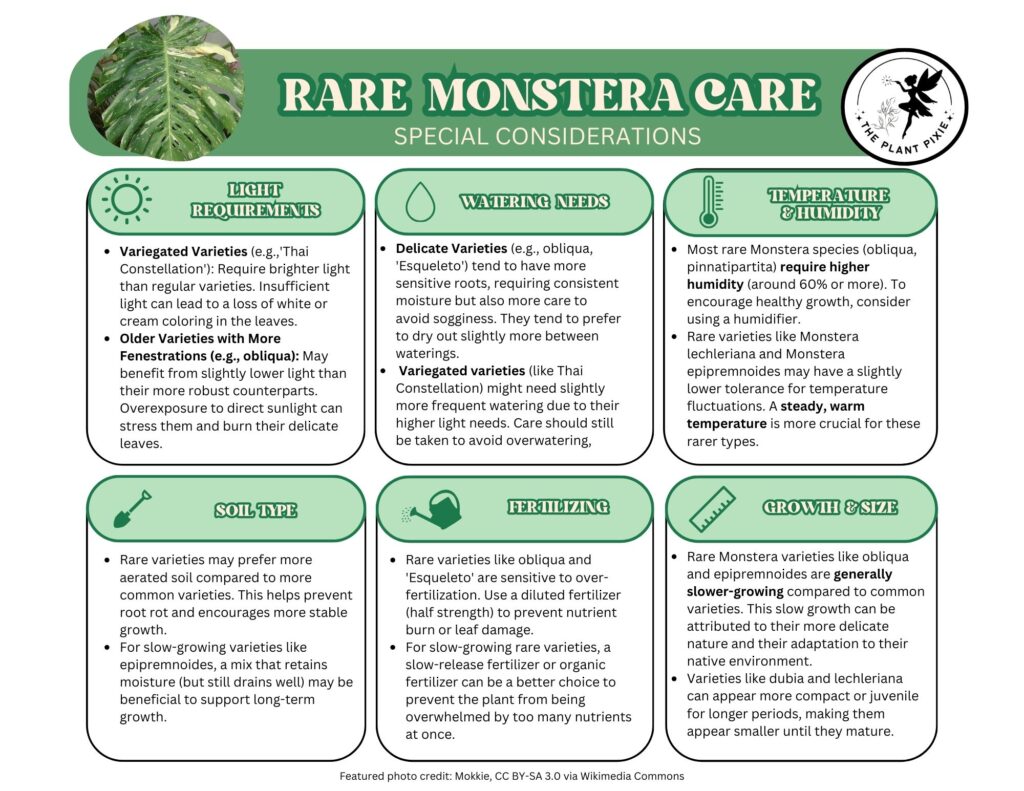
3. Watering and Fertilizing:
- Watering:
- Water when the top 1-2 inches of soil are dry (more frequently in summer, less in winter)
- Ensure proper drainage to prevent root rot—Monstera dislikes sitting in water
- Fertilizing:
- Feed during the growing season (spring and summer) with a balanced, diluted liquid fertilizer
- Reduce or stop fertilizing in fall and winter when the plant is in a dormant phase
4. Common Issues and How to Solve Them:
- Yellowing Leaves:
- Causes: Overwatering, underwatering, poor drainage, or nutrient deficiency
- Solutions: Adjust watering schedule, check for root rot, and fertilize if needed
- Brown Leaf Tips:
- Causes: Low humidity, underwatering, or exposure to drafts
- Solutions: Increase humidity, ensure proper watering, and stabilize room temperature
- Leaf Curling or Drooping:
- Causes: Low light, underwatering, or pest damage
- Solutions: Move to a brighter spot, check for pests, and improve watering routine
- Pests:
- Common pests: Spider mites, mealybugs, scale, and aphids
- How to prevent pests and natural remedies (neem oil, insecticidal soap, regular cleaning of leaves)
5. How to Encourage Fenestrations (Leaf Holes):
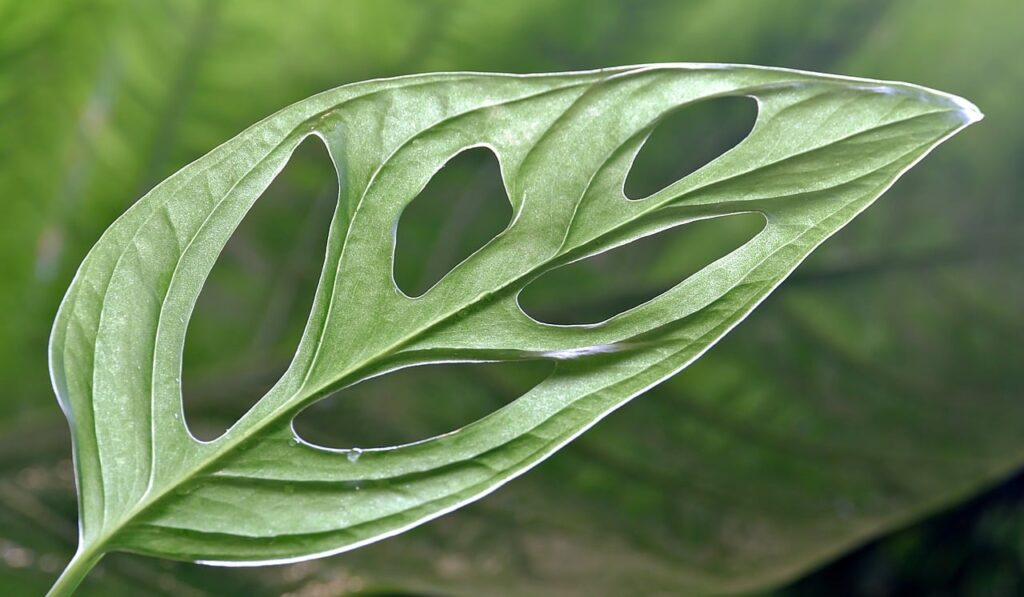
Fenestrations in Monstera plants refer to the natural splits, holes, or perforations that appear in the leaves as the plant matures. These fenestrations are one of the most distinguishing features of many Monstera varieties, such as the Monstera deliciosa, and are believed to help the plant adapt to its environment.
Key points about fenestrations:
- Purpose: Fenestrations allow for better light penetration to lower parts of the plant and improve airflow, which can be particularly important in the dense, tropical environments where Monsteras naturally grow.
- Development: As Monstera plants grow and mature, their leaves start out solid (unfenestrated) and then gradually develop holes or splits as the plant reaches a certain size. This change typically happens once the plant starts climbing or receives adequate light and space.
- Size and Shape: The size, number, and pattern of fenestrations can vary depending on the species and environmental factors like light and space. For example, Monstera deliciosa has large, deep splits, while varieties like Monstera adansonii have smaller, more frequent holes.
- Maturity: Fenestrations are more likely to appear on older, larger leaves, which is why younger plants typically have solid, undivided leaves.
In summary, fenestrations are a signature trait of mature Monstera plants, allowing them to better survive in their natural, humid, tropical habitats by enhancing light access and air circulation.
Encouraging Fenestrations
Encouraging fenestrations (splits or holes) in a Monstera requires creating the right conditions for the plant to mature and grow as it would in its native environment. Here are key steps you can take to encourage your Monstera to develop fenestrations:
1. Provide Bright, Indirect Light
- Why it helps: Monstera plants need bright light to grow strong and healthy. Inadequate light can slow down growth and delay the development of fenestrations. Bright, indirect light mimics the filtered sunlight the plant would get in its native tropical habitat.
- Tip: If you have a Monstera in a spot with low light, consider moving it to a brighter location or supplementing with a grow light.
2. Support Vertical Growth
- Why it helps: In the wild, Monsteras are climbers, using trees and other structures for support. Giving your plant something to climb (like a moss pole, trellis, or support stake) encourages the plant to grow upward and mature faster, which promotes the development of fenestrations.
- Tip: Ensure the support is tall enough for the plant to grow vertically. You can even tie the stems loosely to the pole for better support.
3. Give Your Plant Space
- Why it helps: Monsteras naturally grow large, and they need enough space to spread out. When they have room to grow, they’re more likely to develop fenestrated leaves.
- Tip: Repot your Monstera when it outgrows its pot, and avoid overcrowding it in a small space. Larger pots and more room to grow support better leaf development.
4. Maintain Consistent Humidity
- Why it helps: High humidity is crucial for Monstera plants to thrive and grow well. Humidity helps the plant grow larger, healthier leaves, which increases the chance of fenestrations.
- Tip: Aim for humidity levels around 60-80%. If your home is dry, you can use a humidifier, group plants together, or place your Monstera on a tray with water and pebbles to increase moisture around the plant.
5. Keep Temperatures Warm
- Why it helps: Monsteras are tropical plants and thrive in warm temperatures, typically between 65°F (18°C) and 85°F (29°C). Cooler temperatures can stunt growth and delay the appearance of fenestrations.
- Tip: Keep your Monstera in a warm room away from cold drafts, air conditioners, or heaters.
6. Prune and Train Your Monstera
- Why it helps: Regular pruning encourages the plant to grow in a way that supports strong, healthy leaves. It also helps direct the plant’s energy to producing mature, fenestrated leaves.
- Tip: Trim back any long, leggy stems, especially those with smaller, solid leaves. This will redirect growth to healthier parts of the plant. You can also train the plant to grow up a support structure by tying it gently to a moss pole.
7. Fertilize Regularly (During the Growing Season)
- Why it helps: A healthy Monstera needs sufficient nutrients to grow strong, mature leaves with fenestrations. Fertilizing during the growing season (spring and summer) promotes healthy leaf development.
- Tip: Use a balanced liquid fertilizer or one with a higher nitrogen content to support leafy growth. Fertilize monthly during the growing season, but reduce fertilizing in the fall and winter when the plant is not actively growing.
8. Be Patient
- Why it helps: Fenestrations typically appear only when the plant is large enough and has matured. This may take time, and younger plants (or plants in low-light conditions) may take longer to develop fenestrations.
- Tip: Be patient and continue to care for your plant consistently, allowing it to grow and mature at its own pace.
9. Give It Time to Climb and Mature
- Why it helps: Monsteras develop fenestrations only once they are mature enough, usually when the plant starts to climb and get larger. Young plants may have solid leaves until they are big enough to develop the signature holes.
- Tip: Allow your Monstera to grow tall and start climbing before expecting fenestrations. The bigger and older the plant, the more likely it is to develop the iconic holes.
In summary:
- Key factors for fenestration: bright, indirect light, vertical growth support, high humidity, warm temperatures, and space to grow.
- Patience is essential: Fenestrations generally appear as the plant matures, so don’t be discouraged if they don’t appear immediately.
By providing the ideal environment and care, your Monstera will be more likely to grow large, fenestrated leaves and become the beautiful, mature plant you’re hoping for!
6. Pruning and Propagation:
- Pruning Monstera:
- Why prune: to control size, shape, and promote bushier growth
- Best time to prune: during the growing season (spring and summer)
- How to prune: Cut back leggy stems, remove dead leaves, and manage vining growth
- Propagation Methods:
- Stem Cuttings: Cut just below a node, root in water or soil
- Air Layering: A more advanced propagation method for larger plants
7. Repotting and Potting:
- When to Repot:
- Signs that your Monstera needs repotting: plant outgrows the pot, roots are visible at the surface or out of drainage holes
- Repot every 1-2 years or when it’s showing signs of being root-bound
- Best Potting Tips:
- Choose a pot 1-2 inches larger than the current one
- Ensure the pot has drainage holes to prevent waterlogging
- Use a well-draining, airy soil mix (peat, perlite, orchid bark)
- How to Repot:
- Step-by-step guide to removing the plant, refreshing the soil, and carefully transplanting into a larger pot
8. Benefits of Owning Monstera:
- Air Purification:
- Monstera is part of NASA’s Clean Air Study, improving indoor air quality by removing toxins like formaldehyde and benzene
- Aesthetic Appeal:
- Dramatic, lush foliage and unique leaf shapes make Monstera an eye-catching statement piece
- Fits well in modern, tropical, or minimalist décor
- Low Maintenance:
- Easy to care for with the right balance of light, water, and humidity
- Great for beginners and those who want a low-maintenance plant with a bold look
9. Fun Facts About Monstera:
- Symbolism:
- In some cultures, Monstera is believed to bring good luck, prosperity, and positive energy
- Known for its “cheese-like” holes, hence the name “Swiss Cheese Plant”
- Monstera in Nature:
- Wild Monstera plants grow as epiphytes, climbing up trees to reach for sunlight in tropical rainforests
- The holes in the leaves help with wind resistance and light filtration

